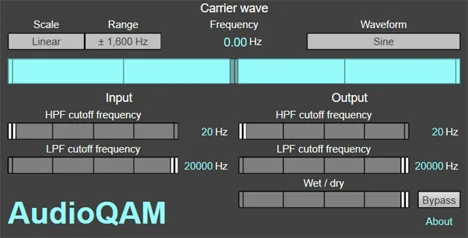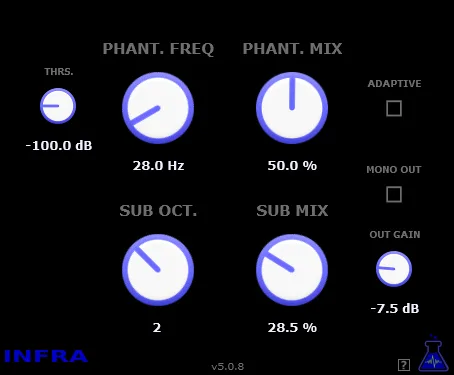AudioQAM: Rethinking Modulation for Unique Sound
In the world of sound design and music production, new tools constantly emerge to expand the palette of available timbres. However, AudioQAM, from developer suzumushi, stands out due to its unique approach, borrowed from a field far removed from music – digital communications. This VST3 plugin is an implementation of the Quadrature Amplitude Modulation (QAM) principle, adapted for audio signal processing. The result? Sounds you’ve hardly heard before.
What is Quadrature Amplitude Modulation in Audio?
QAM is a modulation method used to transmit digital data by simultaneously changing the amplitude and phase (or two phases at a 90-degree angle, hence “quadrature”) of a carrier wave. In communications, this allows for more efficient use of frequency resources. SuzuMushi took this concept and brought it into the audio world, creating an effect that alters sound characteristics in a fundamentally different way than traditional modulation effects, such as chorus, flanger, or phaser, which typically only work with phase or delay, or simpler amplitude modulation effects (ring modulator).
In AudioQAM, your input audio signal acts as the “modulating” signal, and the plugin itself generates a “carrier” wave. The plugin simultaneously modulates the amplitude AND phase of the input audio using this carrier. This dual action creates much more complex and unpredictable harmonic interactions compared to standard AM (which creates sidebands symmetrical to the fundamental frequency) or FM (which creates more complex but predictable spectra depending on the modulation index).
Sound Mechanics: How AudioQAM Works and Carrier Selection
AudioQAM provides the user with the ability to choose one of four classic waveforms for the carrier, and this choice fundamentally influences the final sound:
- Sine Wave: If you choose a sine wave as the carrier, AudioQAM behaves like the well-known Bode Frequency Shifter. This rare and highly valued effect shifts all frequency components of the input signal by a fixed amount up or down the frequency axis. Importantly, it does this without creating harmonics that were not present in the original, unlike pitch shifters based on time stretching or granular synthesis. The result is a clean, but “otherworldly” or “mechanical” pitch shift, ideal for creating surreal atmospheres or subtle “detuning” of the sound.
- Triangle, Square, or Sawtooth Wave: This is where the full potential of QAM for creating truly new sounds is revealed. When the carrier is not a pure sine wave, its spectrum contains additional harmonics (odd for square and triangle, all harmonics for sawtooth). The QAM process in this case, if simplified, can be seen as a “convolution” of the input audio signal’s spectrum with the chosen carrier wave’s spectrum. This means that each frequency component of the input signal interacts with each frequency component of the carrier, generating a huge number of new frequency components (sidebands).
Practically, this manifests in the appearance of complex, non-harmonic or harmonically rich timbres. You can get metallic, resonating sounds, constantly changing textures, digital artifacts that sound musical, or a complete transformation of the input signal into something unrecognizable. The effect often resembles extreme ring modulation or a complex comb filter, but with a unique character derived from the double modulation of amplitude and phase simultaneously.
Unpredictable Results and Creative Possibilities
One of the most interesting features of AudioQAM is its ability to generate “unexpected sounds”. The interaction between the input signal, the carrier waveform, and the plugin’s parameters (carrier frequency, modulation depth) can lead to results that are difficult to predict. This makes the plugin an ideal tool for experimenters and sound designers looking for fresh ideas. Twisting the knobs turns into a journey through uncharted soundscapes. You can transform simple sounds (sine wave oscillators, noises, basic synth timbres) into complex, living textures, or give familiar instruments (guitar, voice, drums) a completely new, otherworldly, or mechanical character.
- Potential Applications:
- Creating unique sound effects for films, games or multimedia (sound design).
- Generating non-traditional timbres for electronic, noise, ambient, or avant-garde music.
- Radical transformation of instruments: make a bass line ringing, turn a piano into a metallic percussive instrument, or give a vocal a synthetic, “robotic” hue.
- Enriching a track with unique, moving sound layers that add depth and originality.
Technical Aspects and Compatibility
AudioQAM is implemented as a VST3 format plugin. It is designed specifically for 64-bit Windows operating systems, starting with Windows 10. The plugin works correctly with any standard sample rate, making it compatible with the vast majority of modern digital audio workstations (DAWs) on this platform.
Conclusion: Expand Your Sound Palette with AudioQAM
AudioQAM is more than just an effect; it is a tool for exploring new sonic territories. Its unique application of Quadrature Amplitude Modulation in audio opens the door to creating timbres that are simultaneously complex, unpredictable, and extremely interesting. Whether you are involved in sound design, writing electronic music, experimenting with avant-garde genres, or simply want to add uniqueness to your mixes, AudioQAM offers a fresh and powerful approach. With the ability to choose between the behavior of a classic Bode shifter (with a sine wave) and the creation of completely new spectral textures (with other waves), this plugin becomes a valuable addition to the arsenal of any creative musician or sound engineer. Try AudioQAM and discover the unexpected sound worlds it will help you unlock!



